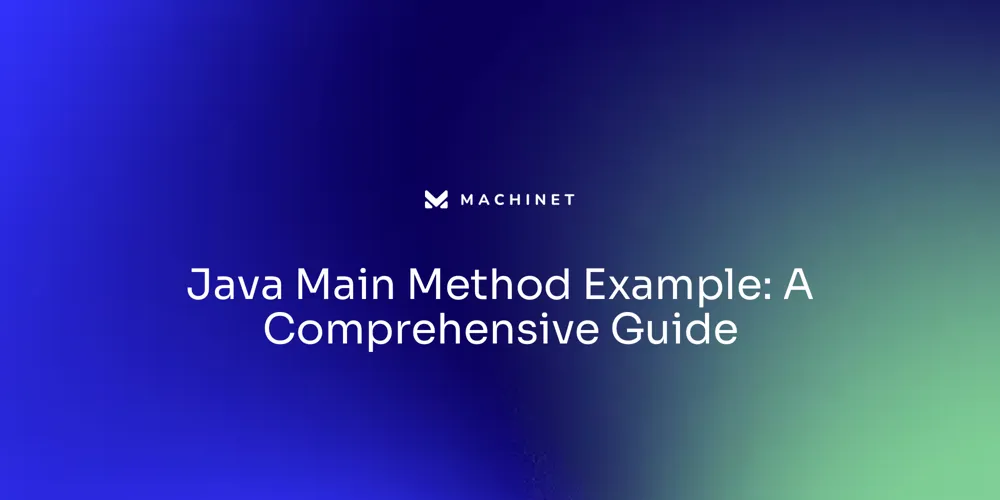
Table of Contents
- Understanding the Java Main Method
- Syntax of the Java Main Method
- Using Command-Line Arguments in the Main Method
- Best Practices for Writing the Main Method
Introduction
At the heart of any Java application lies the main method, a gateway for the Java Virtual Machine (JVM) to breathe life into a program. It is the launchpad from which the JVM initiates the execution of a Java application.
The main method has a signature that is recognized by the JVM: it must be public, static, and void, ensuring it can be invoked without creating an instance of the class and does not return any value. Additionally, it accepts a single parameter: an array of strings, which can store command line arguments passed to the application upon execution. This article will explore the syntax of the main method, the usage of command-line arguments, and best practices for writing an effective main method in Java.
Understanding the Java Main Method
At the heart of any Java application lies the main method, a gateway for the Java Virtual Machine (JVM) to breathe life into a program. It is the launchpad from which the JVM initiates the execution of a Java application. The main method has a signature that is recognized by the JVM: it must be public, static, and void, ensuring it can be invoked without creating an instance of the class and does not return any value.
Additionally, it accepts a single parameter: an array of strings, which can store command line arguments passed to the application upon execution. This method encapsulates the starting point of a program and typically houses the initial instructions of the application. For instance, a simple 'HelloWorld' Java program would execute a main method containing the statement System.out.println("Hello World");, thereby displaying the text on the console.
The clarity and simplicity of this method are crucial, especially for beginners, as it sets the stage for the journey into Java programming. The significance of the main method is reflected in its ubiquity and the fact that Java remains a highly portable and platform-independent language, as evidenced by its use in desktop and web applications across various operating systems. Java's syntax, including the structure of the main method, contributes to its reputation as an approachable language for new programmers.
This simplicity in design has been recently highlighted with the advent of Java 21, which has introduced changes to make the language even more accessible and consistent with other programming languages. These changes aim to reduce barriers for beginners and align Java with the more flexible entry points seen in languages like Python and JavaScript. The evolution of the main method in Java is not just a technical adjustment, but a strategic move to keep Java modern, flexible, and a steadfast tool in the programmer's toolkit.
Syntax of the Java Main Method
In Java, the main method serves as the gateway for program execution, a convention mirrored in many other programming languages. The method's signature is public static void main(String[] args), where each keyword plays a crucial role.
The public keyword ensures that the method is globally accessible, while static means it's associated with the class rather than an instance, which is essential since the method must be invoked without creating an object of the class. The void return type indicates that it does not return any value.
The method's parameters, String[] args, are designed to receive command-line arguments, allowing users to pass runtime information to the program. The simplicity of the main method is crucial for beginners, as pointed out by Sharat Chander from Oracle, who emphasizes the vibrant and ongoing momentum of the Java community in making the language more accessible and modern.
This approach aligns Java with languages like Python and JavaScript, where the entry point is not bound to a specific method. In the context of Java, the main method contains statements like System.out.println, which outputs text to the console, demonstrating the basic functionality of a Java program. Recent updates in the Java ecosystem, such as JobRunr's version 6.3.4, reflect the language's evolution and the community's effort to make Java more compatible and user-friendly. As Java continues to advance, it remains a robust language thanks to the contributions of its community, and developers are encouraged to embrace these changes to stay current with the language development.
Using Command-Line Arguments in the Main Method
In Java, the main method serves as the gateway for program execution, and it's within this method that command-line arguments are processed. These arguments, passed as an array of strings to the args parameter, can be utilized for various runtime configurations. Consider the following example where each command line argument is printed to the console:
java
public static void main(String[] args) {
for (String arg : args) {
System.out.println(arg);
}
}
In this snippet, the args array is iterated over, and each argument is output, demonstrating the fundamental way to handle command-line inputs.
It's important to note that Java source programs are sensitive to case; for instance, 'main' cannot be replaced with 'Main' without causing syntax errors. Adhering to Java's syntax rules is crucial for error-free compilation. The use of command-line arguments extends beyond simple value passing.
They also play a role in setting environment variables, which is a common practice in creating production-quality software. These variables, while set outside the Java application, can be accessed within it, influencing its behavior based on the runtime environment. This interaction with the system environment underlines the dynamic and flexible nature of Java, which has been continuously enhanced over nearly three decades to remain a robust and modern programming language.
Moreover, the practice of refactoring, which entails restructuring existing code without altering its external behavior, is prevalent in software development. It's an essential aspect of maintaining and improving the efficiency and navigability of the codebase. Refactoring not only bolsters code quality but also simplifies the integration of new features and reduces the risk of bugs, thereby facilitating a more agile development process.
Best Practices for Writing the Main Method
Crafting an effective Main Method in Java is like laying a solid foundation for a building. It's the entry point of your application and sets the stage for a robust and efficient program.
To achieve this, your Main Method should be the epitome of simplicity, serving as a launchpad for initializing the application and delegating tasks to other methods or classes, rather than a hub for complex logic. Strive to compartmentalize functionalities into distinct methods or classes, enhancing your code's structure and clarity, akin to the modular design seen in object-oriented programming.
This approach not only aids readability but also aligns with the best practice of maintaining method lengths within 10 to 20 lines, as suggested by seasoned Java developers. Exception handling within the Main Method is crucial, as it acts as a first line of defense against unforeseen issues, ensuring smooth execution and debugging.
When it comes to command-line arguments, clarity is king. Opt for descriptive names that reflect their purpose, facilitating a seamless user experience. Furthermore, providing explicit instructions on how to utilize these arguments is not just courteous, it's essential for user engagement and program success. By embracing these practices, as highlighted in recent tutorials and courses, you'll not only refine your code but also enhance your journey as a Java developer, navigating through the nuances of Java's syntax and features such as the new Optional class introduced in Java 8. Remember, clean code is not just about following rules; it's about creating a maintainable and scalable work of art that stands the test of time.

Conclusion
The main method in Java is the gateway for program execution, serving as the starting point for a Java application. It has a specific signature and accepts command-line arguments.
Java's main method is designed for simplicity, making it beginner-friendly and portable across different operating systems. Command-line arguments can be processed within the main method, allowing for runtime configurations and environment variable settings.
To write an effective main method, keep it simple and delegate tasks to other methods or classes. Exception handling ensures smooth execution and debugging.
Using descriptive names for command-line arguments and providing clear instructions enhances user experience and program success. Follow best practices like modular design, shorter method lengths, and clean code principles to create maintainable Java applications. In conclusion, understanding the syntax of the main method and implementing best practices are key to developing robust Java programs. The simplicity and flexibility of this method make Java accessible while empowering developers to create diverse applications.
Start coding with Machinet and boost your productivity today!
AI agent for developers
Boost your productivity with Mate. Easily connect your project, generate code, and debug smarter - all powered by AI.
Do you want to solve problems like this faster? Download Mate for free now.




